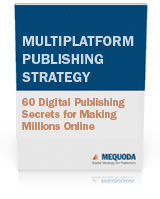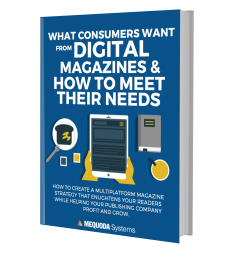These six subscription website systems are turning publishers, associations and other niche businesses into multiplatform media brands
A Mequoda Audience Development System is a digital, turn-key content management system that is customized to help publishers attract new visitors, convert them into email subscribers, engage them, and finally, monetize by converting those visitors into paying customers and subscribers.
To build every Mequoda Audience Development System (Mequoda System for short), we use the Mequoda Method — a collection of best practices that have been formed by watching the world’s most successful online publishers. We also document the results of every a/b and split test that our portfolio of clients are testing every day, and when we see consistent results over time with one methodology, we share it as a best practice with our clients.
Learn how to create sales letter landing pages that sell when you download our FREE Landing Page Handbook.
We build six different types of systems using the Mequoda Method. Haven is the name of our Mequoda Audience Development System, which is why you’ll see it precede each system name.
- The Haven Amherst Subscription Website System
- A free advisory subscription website
- The Haven Bristol Subscription Website System
- A free magazine subscription website
- The Haven Cambridge Subscription Website System
- A premium advisory subscription website
- The Haven Dartmouth Subscription Website System
- A premium magazine subscription website
- The Haven Innsbrook Subscription Website System
- A lead generation subscription website
- The Haven Plymouth Subscription Website System
- An event marketing subscription website
From 1997 – 2007 we were primarily building the Dartmouth, but we weren’t the builders, we were the architects. We deployed hundreds of premium magazine systems during this time, and in 2007 we started building the system ourselves for our clients.
As you can see above, since that time, we have expanded to five other types of Systems.
That’s because traditional publishers aren’t our only clients, we also work with event marketers, lead gen publishers and associations who are looking for an additional stream of advertising revenue and to generate a bigger footprint in the marketplace. And so with a Mequoda System, they enter the world of publishing, because, as the saying goes, “the power of the press belongs to those who own one.”
Let me break down each Haven Subscription Website System.
The Haven Amherst Subscription Website System
A subscription website with the primary goal of giving away free advisory content and generating sponsor revenue.
Examples: NAPA Net, Vida y Salud.
If sponsorship revenue is your goal and your only focus, our Amherst Subscription Website System is the right choice for you organization. This system supports the entire suite of audience development best practices required to make search, email and social media your primary traffic drivers. The system also features the zoned architecture required to deploy a sponsorship-driven program that is native, scarce, exclusive and aligned with your sponsor’s products. In addition to the core website portal, you can add on optional directory, calendar and classified website business models.
![NAPA Net Subscription Website System NAPA Net Subscription Website System]()
An example of a Haven Amherst Subscription Website System is the National Association of Plan Advisors, who developed their system, NAPA Net ,as an additional revenue stream. They developed this free subscription website to attract more sponsors. This is a massive B2B trade organization that has multiple divisions, and spun out this media website on its own. The great news is that it makes money, and it has made money since day one. It contributes both to their margins and their mission. It’s a stunning example of the Haven Amherst Subscription Website System.
The Haven Bristol Subscription Website System
A subscription website with the primary goal of generating subscriptions and sponsor revenue for a free magazine.
If you publish controlled circulation magazines and are looking to move into a fully integrated multiplatform digital sales strategy, our Bristol website business model includes all the features of our Amherst system plus a state-of-the-art HTML web magazine or magazines. Our research is clear that users prefer web magazines over their application counterparts based on the availability and fully responsive nature of a web magazine. Our Haven Gate Publications Manager gives your online magazine all the attributes users expect including a dynamic table of contents, linear navigation from article to article plus a complete cross referenced back issue archive that allows users to browse for content by topic instead of issue. Our clients routinely use their web magazines to anchor their native advertising programs which offer their sponsors a fully integrated state-of-the-art content marketing program.
![Metro Parent Subscription Website System Metro Parent Subscription Website System]()
A shining example of a Haven Bristol Subscription Website System is Metro Parent. They deliver their free magazine in print and through a responsive HTML edition, all made possible by their Bristol system. This wide multiplatform distribution is a major asset to the sponsors whom they rely on for advertising revenue. Metro Parent has also incorporated a calendar and directory into their System which generates additional revenue.
The Haven Cambridge Subscription Website System
A subscription website with the primary goal of generating revenue from a premium advisory service or product.
If your legacy business is powered by premium newsletters or premium advisory services as they are now so often called, our Cambridge website business model is ready to take you into the 21st century. This model includes all the features of our Amherst system and leverages them to build a massive email database of free subscribers that can be up-sold and cross-sold to your premium products. Our system supports individual premium subscriptions and a revolutionary all-access pass that enables you to sell a super high-priced premium product that aggregates all the investments you’ve made in your portfolio of individual subscription products. Our clients routinely have used this strategy to increase revenues by 50 to 100% with a minimal increase in their editorial development costs.
![Cabot Subscription Website System Cabot Subscription Website System]()
An excellent example of the Haven Cambridge Subscription Website System is Cabot Wealth Network, Cabot is one of the oldest and most respected independently-owned financial advisory services in the U.S. They sell several premium advisory services, including specialized investment newsletters and memberships, which includes free access to their annual event (tickets can still be purchased.)
The Haven Dartmouth Subscription Website System
A subscription website with the goal of generating subscriptions and revenue for a premium magazine.
Our most popular website business model is designed to take consumer magazine publishers boldly forward into a multiplatform 21st-century strategy. In addition to our revolutionary HTML web magazine and support for tablet based at magazines, these Systems often include our directory, calendar and classified revenue models. Of course, our Haven Dartmouth Subscription Website System features all the functionality of our signature website portal which can be leveraged for both premium subscription development and third-party sponsorship programs using our native, scarcity, exclusivity and alignment sponsorship program.
Our Haven Dartmouth Subscription Website System is also fully compatible with state-of-the-art subscription fulfillment systems from Strategic Fulfillment Group, CDS Global, and Palm Coast Data. Our cutting-edge multiplatform contrast pricing program coupled with our Six Sigma direct marketing program will allow you to dramatically increase your subscription unit sales and average price per subscriber. The Haven Dartmouth Subscription Website System maintains the strong traditions of a dual revenue strategy powered by subscriptions and sponsorship and also allows you to add new consumer revenue streams powered by an online shop, event marketing system and multi-product consumer clubs.
![Yankee Subscription Website System Yankee Subscription Website System]()
A prime example of the Haven Dartmouth Subscription Website System is New England Network, built for Yankee Publishing, who has a popular regional magazine named Yankee in New England. Like all Dartmouth systems, their website is built to attract, convert, engage, and monetize visitors by converting them into paying magazine subscribers.
The Haven Innsbrook Subscription Website System
A subscription website with the goal of generating leads.
If your marketplace is all about lead generation, our Haven Innsbrook Subscription Website System will take your business to a whole new level. We begin by leveraging the audience development capabilities of our Amherst system and then add on fully integrated lead generation and distribution capability that targets new website visitors and your legacy email subscribers. This highly automated system allows you to do more work and less time while customizing the sponsorship experience in a way that has never before been possible.
![Investing News Network Subscription Website System Investing News Network Subscription Website System]()
Investing News Network is a great example of our Haven Innsbrook Subscription Website System. In order to run a successful lead generation program, they need to be focused heavily on attracting new leads to the site and capturing their email addresses. INN’s System does exactly that, through regularly updated and search optimized content, paired with our 3C Zone Architecture, built to convert visitors into email subscribers and build lists.
The Haven Plymouth Subscription Website System
A subscription website with the goal of selling seats and tickets to premium events.
If you are an event marketer using direct mail or paid media to drive event attendance, our Haven Plymouth Subscription Website System can transform your business processes and your bottom line. Leveraging our core Haven Amherst Subscription Website System capabilities to build a massive permission database of email subscribers, our Haven Plymouth Subscription Website System is capable of dramatically lowering your cost per order and allowing you to launch new programs with minimal risk. Our fully integrated audience database leverages user behavior and past event attendance to customize the user experience and allow you to use your marketing inventory in the most efficient manner possible.
The Haven Plymouth Subscription Website System can be added to any of our Bristol, Cambridge, Dartmouth and Innsbrook Subscription Website Systems to power your event marketing programs for live events, webinars and online learning systems.
![PON Subscription Website System PON Subscription Website System]()
An example of a Haven Plymouth Subscription Website System that is seeing great success is The Program on Negotiation at Harvard Law School. Founded in 1983 as special research project at Harvard University, the Program on Negotiation (PON) is dedicated to developing the theory and practice of negotiation and dispute resolution. PON includes faculty, students, and staff from Harvard University, Massachusetts Institute of Technology and Tufts University. The launch of their Haven Plymouth Subscription Website System included an abundance of free content and free reports, plus a plethora of paid products including a newsletter and their premium events, which drive the majority of their revenue. Since launching their Haven Plymouth Subscription Website System, their revenues have grown by more than 60%, programs are often filled to capacity, and they’ve added new programs as well. Meanwhile, the cost of marketing via direct mail was 32% of the budget; today, their total marketing spend is a mere 7%, with all event tickets now generated from their Haven Plymouth Subscription Website System and their email list.
Would you like to learn more about our six subscription website systems and see which fits your business best? Schedule a call to chat with Don and Julie about the possibilities.
The post Mequoda Announces 6 Subscription Website Systems for 2017 appeared first on Mequoda Daily.
![The Multiplatform Publishing Strategy Handbook]() Discover how to turn one product into ten when you download our FREE Multiplatform Publishing Strategy Handbook.
Discover how to turn one product into ten when you download our FREE Multiplatform Publishing Strategy Handbook.
 Digital magazine subscribers confessed to us everything they want in a digital magazine. Find out what they said in our FREE downloadable
Digital magazine subscribers confessed to us everything they want in a digital magazine. Find out what they said in our FREE downloadable 



















